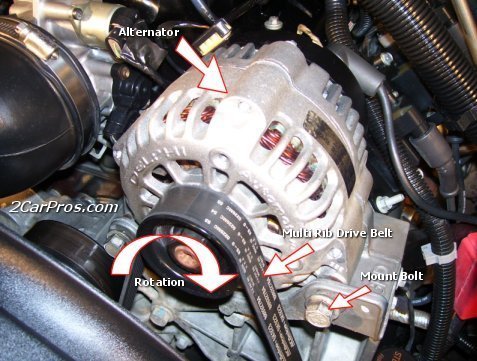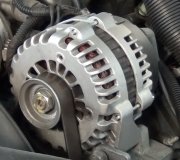I'm in the middle of Wisconsin, so I'm in the central time zone too. My problem is I had a major house fire three years ago, so I don't have internet at home. I have to drive 21 miles to town to sit in my library's parking lot and use their wireless internet. Sometimes I skip a day to save a few bucks on gas.
Don't worry about voltage readings when the engine is not running. The alternator's field circuit gets its 12 volts from the automatic shutdown, (ASD), relay, and the computer turns that on when the engine is rotating, (cranking or running). That relay also sends current to the injectors, ignition coil, and fuel pump or pump relay.
That green wire has nothing to do with running the Engine Computer. It is strictly the control wire for the alternator. If you are familiar with the older system with that electronic voltage regulator, every wire under the hood of those early '70s cars that was dark blue got 12 volts on it when the ignition switch was on. That included a blue 12 volt feed to one brush on the alternator, and a blue 12 volt wire to the regulator. That wire at the regulator was to power the internal circuitry, and that was where the regulator monitored system voltage.
For current to flow through any circuit, it has to have a complete path from and back to the battery. We have the 12 volts up to the first brush on the alternator, then for the rest of the circuit, current flows through the second brush, through the green wire, through the regulator, then to ground and back to the battery.
Chrysler kept the green wire on the newer vehicles for the control wire. Your switching is done by that ASD relay instead of the ignition switch. The rest of the system is the same except the voltage regulator is built into the Engine Computer. That was done so the regulator could modify target charging voltage for a variety of conditions. The old electronic units had temperature compensation built in. With the regulator in the computer, it can adjust charging voltage in anticipation of the AC compressor turning on, changes in battery temperature, and it can stop the alternator from working momentarily when it needs that five horse power, like during wide-open-throttle.
Once the current flows through the regulator, it goes to ground through the pair of "power" ground wires. "Power" grounds just means they are for the high-current circuits including injectors, relays and solenoids, and anything else that will be pulsing or varying. There's two other "signal" ground wires for sensor circuits. Each ground wire has a duplicate in case one has a less-than-perfect connection.
The regulator monitors system voltage on one of the multiple 12 volt feed wires to the computer. That circuit doesn't cause charging problems because it is also used for other functions. Typically the engine won't even run when any of those 12 volt feeds is missing, so you'd be diagnosing a no-start condition, not a charging problem.
Getting back to your truck, the secret is there is almost the same voltage on the two field terminals. No voltage is being dropped across the field winding. That means no current is flowing through it. No current means no magnetic field is being built up in that field winding, so no output current will be generated.
There's two ways to find the cause of the no-charge. One is to measure the voltage on that green wire in various places. There's a connector in the harness between the engine and the body, and there's the terminal at pin 20 at the computer. You will find the same 12.4 volts all the way along that wire up to the break, then it will be 0 volts after that break. The cover can be popped off the computer connector, then you can back-probe the green wire there. If you find 12.4 volts right up to the computer, either that terminal is spread and not making good contact, or the regulator circuit is indeed open again. If the terminal is spread, pushing and twisting on the wire will usually get it to make intermittent contact long enough for you to verify it is having some effect. You might also suspect that wire is burned off the terminal.
The second way to find the break is to ground the green wire in various places. That will "full-field" the charging system and make it run wide open by bypassing the regulator, just like we did on the '70s systems. Turn on the head lights or connect the voltmeter to the battery so you have something to observe to show the charging system is working. You can also listen to the engine being loaded down and the increased whine of the alternator. System voltage will go too high when you do this, so do it just long enough to determine the result. Full-fielding is done as part of a charging system test to determine if the alternator is capable of developing its rated output current. If you back-probe the wire right at the computer, then ground that wire, and system voltage rises a lot, that tells you the green wire is good up to that point.
Thursday, June 15th, 2017 AT 10:19 PM



